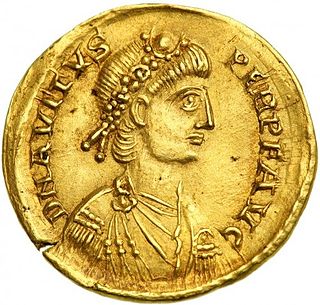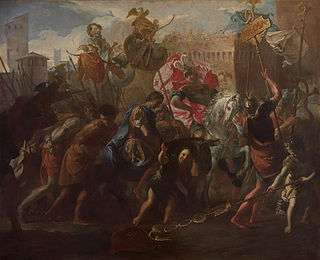Related Research Articles
The 430s decade ran from January 1, 430, to December 31, 439.
Year 438 (CDXXXVIII) was a common year starting on Saturday of the Julian calendar. At the time, it was known as the Year of the Consulship of Theodosius and Glabrio. The denomination 438 for this year has been used since the early medieval period, when the Anno Domini calendar era became the prevalent method in Europe for naming years.
Flavius Aetius was a Roman general and statesman of the closing period of the Western Roman Empire. He was a military commander and the most influential man in the Empire for two decades (433–454). He managed policy in regard to the attacks of barbarian federates settled throughout the West. Notably, he mustered a large Roman and allied (foederati) army in the Battle of the Catalaunian Plains, ending an invasion of Gaul by Attila in 451, though the Hun and his subjugated allies still managed to invade Italy the following year, an incursion best remembered for the Sack of Aquileia and the intercession of Pope Leo I. In 454, he was assassinated by the emperor Valentinian III.

Eparchius Avitus was Roman emperor of the Western Empire from July 455 to October 456. He was a senator of Gallic extraction and a high-ranking officer both in the civil and military administration, as well as Bishop of Piacenza.

The Battle of the Catalaunian Plains, also called the Battle of the Campus Mauriacus, Battle of Châlons, Battle of Troyes or the Battle of Maurica, took place on June 20, 451 AD, between a coalition, led by the Roman general Flavius Aetius and the Visigothic king Theodoric I, against the Huns and their vassals, commanded by their king, Attila. It proved to be one of the last major military operations of the Western Roman Empire, although Germanic foederati composed the majority of the coalition army. The exact strategic significance is disputed. Historians generally agree that the siege of Aurelianum was the decisive moment in the campaign and stopped the Huns' attempt to advance any further into Roman territory or establish vassals in Roman Gaul. However, the Huns looted and pillaged much of Gaul and crippled the military capacity of the Romans and Visigoths. Attila died only two years later, in 453. After the Battle of Nedao in 454, the coalition of the Huns and the incorporated Germanic vassals gradually disintegrated.

This is a chronology of warfare between the Romans and various Germanic peoples. The nature of these wars varied through time between Roman conquest, Germanic uprisings, later Germanic invasions of the Western Roman Empire that started in the late second century BC, and more. The series of conflicts was one factor which led to the ultimate downfall of the Western Roman Empire in particular and ancient Rome in general in 476.
The Gothic Wars were a long series of conflicts between the Goths and the Roman Empire between the years 249 and 554. The main wars are detailed below.
Gothic War may refer to:

Theodoric I was the king of the Visigoths from 418 to 451. Theodoric is famous for his part in stopping Attila the Hun at the Battle of the Catalaunian Plains in 451, where he was killed.
Flavius Merobaudes was a Roman army officer of Frankish origin. He was appointed magister peditum around 375, and consul twice in 377 and 383. Ancient sources record that he was put to death that year for his support of the imperial usurper Magnus Maximus, but an inscription records that he became consul a third time in 388.

Litorius was a Roman general of the closing period of the Western Roman Empire serving as Magister militum per Gallias mainly in Gaul under magister militum Flavius Aetius. Litorius is noted for being the last Roman commander in the ancient Roman military history to perform pagan rites and the consultation of auspices before a battle.

The Gothic revolt of Theodoric I was an uprising of the Gothic Foederati in Aquitaine during the regime of Emperor Valentinian III (425-455). That rebellion was led by Theodoric I, King of the Visigoths and took place in the South of France. The uprising took place between 425 and 426, in the period shortly after the death of usurpator John and was terminated by a military operation under the command of Aëtius.

The Gothic War (436–439) was a military conflict between the Gothic foederati and the Western Roman Empire under Emperor Valentinian III. It occurred primarily in the Gallic provinces from 436 to 439. The key figures involved were the Gothic leader Theodoric I and the Roman army's commander-in-chief, Aetius. Contemporary sources characterize this conflict as a war. Additionally, there were uprisings of the Burgundians and the Bagaudae during the same period.

The Gothic War in Spain of 456 was a military operation of the Visigoths commissioned by the West Roman emperor Avitus. This operation consisted of an extensive campaign aimed at reclaiming the Spanish provinces of Lusitania and Betica that were in the hands of the Suebi and threatened Roman power in the provinces of Cartaginensis and Tarraconensis. The main players in this war were Theoderic II who led the army of the Visigoths and Rechiar the king of the Suebi. The Visigothic army was supported by Franks and Burgundian auxiliary troops.

The Gothic War of 457–458 was a military conflict between the Visigoths of Theoderic II against the Western Roman Empire of Emperor Majorian. The war began in 457 with a revolt of the Goths in Aquitania that pushed aside Roman authority, followed by an aggressive conquest in the adjacent Septimania aimed at area expansion. The war ended with a Roman victory over the Goths in the Battle of Arles in 458.

The Vandal War (439–442) was a military conflict between the Western Roman Empire and the Vandals that was fought in the western Mediterranean Sea region. The main protagonists in this conflict were the Vandal king Geiseric and the commander-in-chief of the Roman army Aetius.

Aetius' campaign in the Alps was a military campaign of the Roman army in the northern Alpine region, where the dioceses Raetia and Noricum were situated. The campaign was directed against the Juthungi and the rebellious population of Noricum. The command of the campaign was in the hands of magister militium Aëtius and it began in the spring of 430 CE. In May, the campaign was interrupted to continued the following year.

The Frankish War of 431–432 was a short war between the Franks and the Western Roman Empire under Emperor Valentinian III. Like the previous Frankish war, the Roman army was led by the Roman general Aetius and the participation of Chlodio, the king of the Salian Franks is uncertain. The war ended in a Roman victory after which both sides agreed to a peace treaty.

Frankish War (441–446) was a multi-year military conflict in the provinces of Germania II and Belgica I during the reign of Emperor Valentinian. In addition to the Western Roman Empire, the two tribal associations of the Franks were involved: the Salian Franks and the Ripuarian Franks. The main players in this conflict were Flavius Aetius and Chlodio.